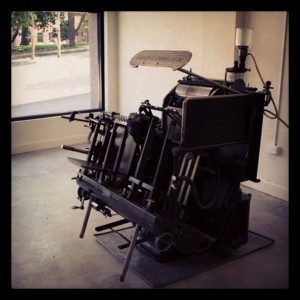Article: The Distillery - Purifying Letterpress
The Distillery letterpress studio stands for the custom craftsmanship and artisan skill of a bygone era; hands instead of code behind something; ink instead of pixels. I spoke with the company's director Nathan Leong about the near-lost art of letterpress.
I went through a phase of writing unexpected letters recently. With the incessant emails that badgered my inbox I needed to get away from screens, so I began penning letters to friends I hadn’t seen in a while.
It’s fascinating how in just a couple of years, the growing dependence of our daily lives on computers, whether they’re on your lap or in your pocket, has completely changed our relationship with paper. The temporal nature of the content on your screen has made the permanence of paper – and the words printed on it – feel more meaningful.
And in a time of ever-increasing digital reliance, it’s nice to hear the clunky wheels and cogs of a machine that can create something beautiful sans electricity. Down at The Distillery in Darlinghurst, the old letterpress machines from the 1890s click, whistle and turn, making music instead of a buzzing drone like computers. The letterpress studio stands for the custom craftsmanship and artisan skill of a bygone era, when there were hands instead of codes behind something; ink instead of pixels.
The Distillery’s director Nathan Leong and his team are working to bring back letterpress and the traditional design process that sees a piece through its entire lifetime from start to finish. This is not only through oiling, restoring and reigniting the old machines, but by holding workshops teaching letterpress skills, and renting out time on the letterpresses to local enthusiasts, so the studio can become a creative community hub.
I spoke with Nathan a few months ago on why he’s dusting off these machines and spreading the the love of this old artisan skill.
What were you doing before The Distillery?
I was a consultant at a big consultant company so I was going around, getting rid of jobs, telling big business how make their processes and management more efficient. I think it comes back to the fact that everyone has an analytical and creative side and I’ve always known I want to do my own thing so I knew it was either going to work or fail, so I just bought the press and gave it a shot.
Letterpress in Australia was nearly lost – why did you feel the need to reignite it?
We’re a capitalist society and the trend over the past few years has been mass-produced and things made in bulk in China, and to a certain extent a loss of individualism. And yet we’re all unique people so the need for this type of work and of real-world, tactile experiences is so important. It’s like a home-cooked meal in comparison to takeaway – doing things the old fashioned way has a lot of soul, and people long for that. The need for letterpress taps into that need – to make a connection with people. It helps them pause. We’re all time centric and it comes back to sitting back and reflecting. Letterpress makes people stop and appreciate design which is what life is about – enjoying things.
How did you learn about letterpress?
I had a friend of a friend who was a letterpress teacher so through them I was able to learn to print. It’s not actually as easy as learning apple P or control P. It’s a lot of work and took a long time. It’s a trade. You can’t just press print. There’s about 10 to 20 things that can go wrong with a print, not because of the printmaker, but because it’s tricky. If you’re out by a quarter of a millimetre in terms of the printing plate you’ll notice it quite quickly. If the paper isn’t picking up properly by the machine or the ink is coming out slightly the wrong colour, it’s going to look wrong. And these things are usually done by a laser printer, but to do it manually is a lot of craft.
What’s been the biggest challenge?
Well the Chandler Bing machine is from 1890, Aladdin is from 1920, Wolfgang is from ‘59 – you can’t just go down to Bunnings to buy a new part for these things. We accidentally broke our press once and there’s only one guy in Australia who can fix it and he’s 75 or 80, so the challenge is not freaking out too much and learning to fix the problem yourself. It’s not like you can take it into a car servicing area, there’s only a very few people who know how to fix these machines.
You said you believe letterpress has an important role to design in the future, is that because of the step away from mass production?
Yeah it’s important as a society that we don’t lose soul and heritage. Our history defines who we are, along with our future. Letterpress harks back to the methodology process. We’ve been going in a direction of; quicker, faster, mass produced and a reliance on Third World solutions to feed First World issues. And craftsmanship and process is lost in that. We can’t forget about our roots, and letterpress is compatible with an aspect of design which invokes aspects of life and our history. We can’t forget where we come from as a society. It’s part of our identity.
What influences your design?
Photos of the old Harbour Bridge and the Old Sydney Town feel very much influences our colour palette, logos and even the work we do for our clients. We really want to be a Sydney design studio that considers our heritage. Obviously not everything is going to be compatible to that style but it’s a modern way to implement vintage, heritage design with soul. Our strength is creating something that has soul to it and often we try to tie that back to who we are and where we are which is in Sydney.
And you’re introducing letterpress workshops?
Yeah we’ll teach people here at the studio. We’re going to start with how things were done traditionally, but most people want to do the new way too. So we’ll start with the traditional way, then they can do some designing at home, come back and print the new way too. We see The Distillery as a community and the classes are the future.
My vision is for people to come here and once they’ve trained and know safety, they can rent printing time for themselves. We literally want to spread the love of doing things through process and the old way. Printmaking says a lot about imperfections. There’s a whole bunch of people out there who are disillusioned with designing for websites or having to do things through a computer – like letter writing as you mentioned – we want to help grow that aspect of society and design. And that’s how we see the future; not so much as printers printing wedding invites but – and this is corny as hell but – making the world a better place through process and old design.
















